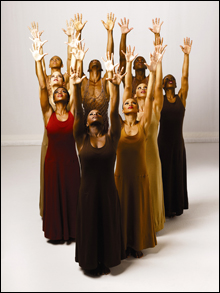
REVELATIONS: The finale now is less a
gathering of individuals than a corporate
celebration. |
The newest work on the Alvin Ailey American Dance Theater’s program at the Wang Theater last Thursday (the first of five performances in a Celebrity Series–sponsored visit), The Groove to Nobody’s Business (2007), looked back half a century, to the company’s earliest success. Blues Suite, which premiered on Alvin Ailey’s first concert, in 1958, not only established the charismatic Ailey as a formidable choreographer but unwrapped a cluster of character types that have influenced the popular stage to this day. Neither the Ailey company nor The Groove’s choreographer, Camille A. Brown, acknowledged these roots.
Like Blues Suite, The Groove sketches a bunch of characters, mostly strangers, who are temporarily thrown together in a public place. In Blues they gathered in a Down South saloon; in The Groove it’s a city street, a subway station, and a moving train.
To two songs by Ray Charles and some instrumental background by Brandon McClune, nine persons come and go, doing their own thing, getting in one another’s way, showing off, claiming space, being sexy, being annoying, trying to hide. They all seem to be in some state of exasperation, which they vent in souped-up solos. Their nervous energy sporadically collides and meshes in chorus lines of leg-crossing, shoulder-twisting, push-away gestures.
They interact in superficial ways but they seem cartoonish. Brown gave each character a freakishly exaggerated physical tic: stuck-out butt, swiveling hips, stiff-legged double-time running steps, flirtatious gyrating wrists. The dancers themselves almost disappeared into these signifying faces and postures.
After Blues Suite, Alvin Ailey continued to create funky communities and individual portraits. Flowers, a devastating 1971 reflection on Janis Joplin and the star phenomenon, was given on Friday. In the soulful Revelations (1960), after rituals and choreographed expressions of devotion and repentance, this humanizing influence comes into play again as the women stroll on in Sunday finery, greet one another animatedly, and prepare us for the joyous romp that ends the dance.
Revelations lives now in a constant state of inflation and embellishment. The original covey of three churchgoing ladies has exploded to nine, soon to be joined by nine men, and the finale now is less a gathering of individuals than a corporate celebration. The dance’s newly recorded spirituals and praise songs deliver superhumanly stretched-out climaxes and virtuosic gospel singing that often engulfs the melody altogether. Thursday’s cast delivered Revelations with customary polish, and Alicia J. Graf and Jamar Roberts managed to extract some simple piety from a prettified “Fix Me, Jesus.”
Robert Battle’s new duet, Unfold, for Linda Celeste Sims and Clifton Brown, evaded both Ailey’s gesture-into-dance formula and the love-is-violence route of most contemporary duetmeisters. To a recording of Leontyne Price singing the exceedingly romantic “Depuis le jour,” from Charpentier’s opera Louise, the dancers bend and sprawl and pick their way around each other. Sims stretches in a rubber-band backbend. Brown grips her efficiently but without passion. Interesting that the company cast two of its most elegant dancers to make this absurdist comment on Price’s “souvenirs charmants.”
This year the Aileys revived an iconic work by the guru of European counterculture and pioneer of Euro-trash, Maurice Béjart, who died this past November at age 80. Firebird (1970) used one of the suites from Stravinsky’s famous ballet. Dispensing with the original plot, which was first choreographed in 1910 by Michel Fokine, Béjart made a formal composition for a group of eight partisans in guerrilla uniforms who get their inspiration from a mythic figure in a red unitard (Clifton Brown).
This spirit — Béjart identified him as a poet, revolutionary, symbol of life and joy — dances balletic leaps and spins as the group hover decoratively around him, inhaling the essence of rebellion. Eventually he dies, but his expiring figure merges with a new Firebird (Jamar Roberts) to carry on the image of resistance. No one actually fights in this formalist appeal to the fervent revolutionaries of its day. Maybe modern viewers will read it as a plug for gay marriage.